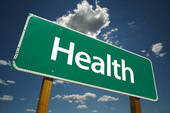 1. Bloody eye. The eye’s transparent outer layer, called the conjunctiva, is nourished by numerous tiny blood vessels. If these burst, blood may pool on the white of the eye (sclera). A subconjunctival hemorrhage, as it is known among doctors, can be caused by a blow to the eye but in most cases has no obvious cause. In rare instances, a subconjunctival hemorrhage can be a sign of severe high blood pressure or a platelet disorder, which can interfere with clotting, Williams tells WebMD.
1. Bloody eye. The eye’s transparent outer layer, called the conjunctiva, is nourished by numerous tiny blood vessels. If these burst, blood may pool on the white of the eye (sclera). A subconjunctival hemorrhage, as it is known among doctors, can be caused by a blow to the eye but in most cases has no obvious cause. In rare instances, a subconjunctival hemorrhage can be a sign of severe high blood pressure or a platelet disorder, which can interfere with clotting, Williams tells WebMD.2. Bulging eyes. Though prominent eyes may simply be a family trait, eyes that appear to bulge may be evidence of thyroid disease. Abnormal levels of thyroid hormone cause tissues surrounding the eye to swell, making it appear that the eye is bulging.
4. Pupil abnormalities. The pupils of healthy people are usually (but not always) symmetrical. They’re usually of the same size, and they usually show the same reaction upon exposure to light. If one pupil is bigger than the other, or if one pupil shrinks less, or more slowly, on exposure to light, there could be an underlying medical problem. Possibilities include stroke, brain, or optic nerve tumor, brain aneurysm, syphilis, and multiple sclerosis (MS). Finally, many medications -- including illicit drugs -- can cause the pupils to appear unusually small or large, says Peter Kastl, MD, PhD, professor of ophthalmology, Tulane University School of Medicine.
Thickened eyelid. In very rare cases, a thickening or deformation of the eyelid is a sign of neurofibromatosis, a rare hereditary disorder marked by the growth of tumors along nerve fibers (the tumors themselves are called plexiform neurofibromas). Joseph Merrick, the 19th Century Englishman known as the Elephant Man, was long thought to have had neurofibromatosis. But experts now believe that he suffered from another rare condition known as Proteus Syndrome.
6. Yellow eyes. Diseases of the liver, including hepatitis and cirrhosis, can turn the scleras yellow. The color is caused by the buildup of bilirubin, a compound created by the breakdown of hemoglobin, the oxygen-carrying molecule inside red blood cells. The medical term for yellow eyes is scleral icterus -- even though it’s not actually the scleras that turn yellow, but the conjunctiva.






